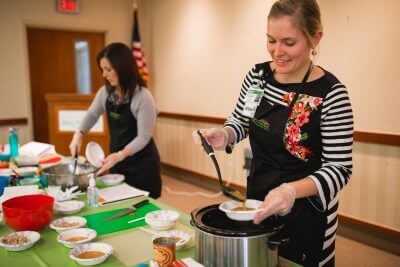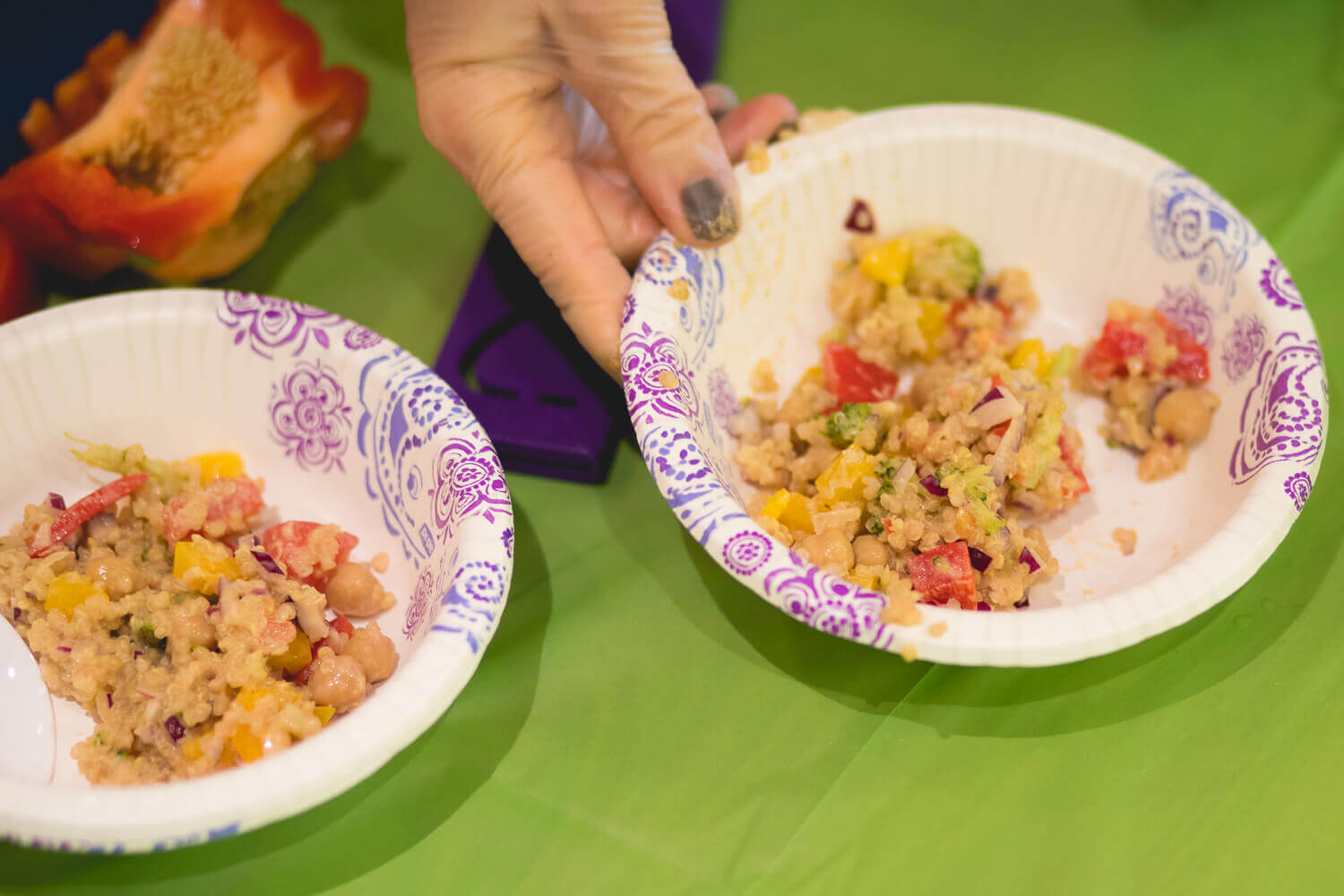Posted on February 15, 2017
Creativity in the kitchen can inspire healthy eating
Have your 2017 wellness resolutions stalled? Creativity in the kitchen can rekindle and refocus your nutrition goals. Mary Free Bed registered dietitians Jessi Boehme and Joanna Gritter (pictured below, right to left) are doing their part to keep hospital staff motivated with healthy, on-site cooking and recipe demos. Here, Jessi shares guidelines for healthy dishes recently shared during employee cooking and tasting events.
 We explored two recipes during the recent cooking demos for Mary Free Bed employees – an apple butternut squash soup, and a lemon tahini quinoa salad. (Click on the dish name for a downloadable recipe card.)
We explored two recipes during the recent cooking demos for Mary Free Bed employees – an apple butternut squash soup, and a lemon tahini quinoa salad. (Click on the dish name for a downloadable recipe card.)
Why soup and salad? Given the colder temperatures, something warm paired with something cold seemed a good balance. And who doesn’t love that classic combo? We chose a butternut squash soup because squash currently is in season, so it’s fresh and inexpensive. Squash also is full of vitamins, minerals and is a good source of fiber.
There are a variety of ways to cook squash, but one method we love in particular is the slow cooker method. Simply remove any purchasing stickers, place the squash in an empty, non-greased slow cooker and set the heat on low for four to five hours, or on high for two to three hours. Remove the squash, allow it to cool and cut it in half, scooping out the seeds. You’ll easily be able to scoop out the body of the squash. Don’t worry if you end up with some skin from the squash in your soup. It will be easy to puree without any noticeable extra-chewy chunks.
As for the salad, have you ever tried tahini? It’s similar to peanut butter (which you can use instead) but is made from ground sesame seeds rather than peanuts. The taste is not sweet like a traditional peanut butter (because it does not have added sugar), but rather earthy and smooth. Many people use it as a dip or as a dressing, either plain or with additional ingredients like the ones in the recipe.
 Another possibly new ingredient that makes this salad extra fun is quinoa (pronounced “keen-wah”). It is a filling whole grain packed with protein and fiber. Quinoa cooks just like rice and can really make a recipe stretch. Its nutritional content makes it a good change-of-pace from rice and pasta.
Another possibly new ingredient that makes this salad extra fun is quinoa (pronounced “keen-wah”). It is a filling whole grain packed with protein and fiber. Quinoa cooks just like rice and can really make a recipe stretch. Its nutritional content makes it a good change-of-pace from rice and pasta.
Wondering whether to use fresh, frozen or canned produce or beans? Joanna and I support all three options! It is OK to use frozen if you need to speed up a recipe or grab some low-sodium canned chickpeas instead of soaking your own. If cooking already feels like a time-consuming and daunting task, don’t shy away from saving yourself a step or two in the process.
One last tip; when looking at recipes, if you find an ingredient you do not typically like or prefer a different variety (like red peppers instead of green) feel free to change it up! In fact, the more creative you get with colors and varieties of food, the more likely you are to enjoy your meal and cook from scratch again in the future. Maybe you want to try acorn squash or swap in barley for quinoa.
Let us know if you try one or both of the recipes by leaving your feedback in the comments section below. Want more guidance for getting back into the kitchen? Our Outpatient Nutrition Services allows you to meet one-on-one with a registered dietitian and develop a plan to fit your healthy goals and needs, while our Weight Management Program provides a medically-supervised path to weight loss and nutritious eating.





